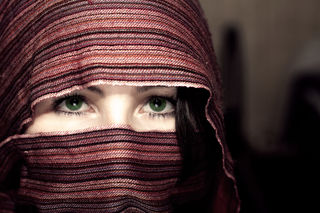Deception
What Is the Face of Truth?
A new study contradicts rulings about Muslim garb on the witness stand.
Posted August 3, 2016
By Emily Silber

How much of a person’s face is it necessary to see in order to discern whether the person is lying—say, on a witness stand? A new study suggests that it’s a lot less than you think. And the study findings directly contradict past rulings in the U.S., Canada, and the U.K. banning female witnesses from wearing garments that cover everything but their eyes.
Contrary to conventional belief, when determining whether a person is lying, the less you see, the better, researchers report in the journal Law and Human Behavior. In fact, they found clothing that minimizes visual cues can actually improve the ability of observers to detect lying.
In response to courts forbidding female witnesses from wearing niqabs, Muslim garments that cover everything but a person's eyes, a team from the University of Ontario in Canada and the University of Amsterdam in the Netherlands decided to test the theory underlying the bans: It's necessary to see a person's face to determine whether he or she is lying.
In two experiments, participants had to judge the honesty of several witnesses in a mock theft trial.
To set the stage, the witnesses, all women, were shown one of two versions of a video: One depicted a person watching a stranger's bag, the other showed the person stealing from the stranger's bag. All the women were told that they would have to testify on that person's behalf.
During the interrogation, some of the witnesses wore a niqab, others wore a hijab, which covers the head and body but not the face, and others wore ordinary garb. The “trials” were filmed and then shown to university students in Canada, the U.K., and the Netherlands. The students were asked to identify which defense witnesses were lying in their testimony (half of them, the ones who saw the video theft, had to lie to make their case)—and how they came to their decision.
Surprisingly, the students were better able to detect deception in the women whose faces were veiled. In one experiment, 232 students were 55 percent accurate in detecting lying among the niqab-wearers, 58 percent accurate in detecting deception among the hijab-wearers, compared with a 52 percent accuracy rate for those wearing no veil. In the second experiment, with 291 students, they were 57, 59, and 51 percent accurate, respectively. “It was only when witnesses wore veils that observers performed above chance levels,” the researchers report.
The students observing the niqab- and hijab-wearing witnesses could see fewer nonverbal cues than they could of the unveiled witnesses, says Amy-May Leach, professor of social science and humanities at the University of Ontario and co-author of the study. They had to rely more on verbal cues of lying. “Research suggests that verbal cues are more diagnostic of deception than nonverbal cues.”
Leach explains that veils reduce nonverbal cues that may be distracting and even misleading, such as sweating or facial expressiveness. It forces the observer to switch deception-detection strategies and rely on vocal cues, such as stuttering, grammatical errors, and vocal tension.
Many of the students watching the veiled witnesses actually turned away from the trial videos to make their determination—suggesting they were listening more closely and paying “more attention to implausibilities, inconsistencies, and the amount of detail,” says Bennett Kleinberg, psychology professor at the University of Amsterdam and study co-author. “All of those elements have been shown to help discriminate truthful from deceptive statements.”
Negative stereotypes of Muslims, especially veiled Muslim women, had led the researchers to predict that study participants would be more likely to find that the veiled women were lying, regardless of the strength of their testimony. But the researchers were proved wrong.
“I was surprised by the lack of response bias,” says Leach. She’s not sure whether the lack of bias among the participants was due to concurrent local media campaigns portraying veils in a positive light or to the fact that the participants were university students and generally more educated about Muslims.
None of the women witnesses in the study were veil-wearers in real life. Nevertheless, says Leach, the assumption held by the justice system—that it is essential to see one’s face in order to render lie detection decisions—is false. “Our results suggest that niqabs should not be banned from the courtroom on that basis.”


